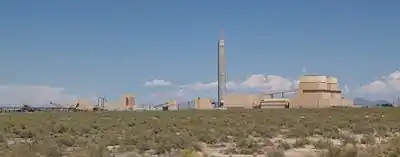Intermountain Power Plant
Intermountain Power Plant is a large coal-fired power plant at Delta, Utah, USA. It has an installed capacity of 1,900 MW, is owned by the Intermountain Power Agency, and is operated by the Los Angeles Department of Water and Power.[1][2][3][4]
| Intermountain Power Plant | |
|---|---|
 Aerial view of Intermountain Power Plant, Utah | |

Location of the Intermountain Power Plant in Utah | |
| Country | United States |
| Location | Delta, Utah |
| Coordinates | 39°30′27″N 112°34′49″W |
| Status | Operational |
| Construction began | September 1981 |
| Commission date | June 1986 |
| Construction cost | US$4.5 billion |
| Owner(s) | Intermountain Power Agency |
| Operator(s) | Los Angeles Department of Water and Power |
| Thermal power station | |
| Primary fuel | Coal |
| Power generation | |
| Units operational | 2 X 950 MW |
| Make and model | GE Babcock & Wilcox |
| Nameplate capacity | 1,900 MW |
| External links | |
| Commons | Related media on Commons |
It is scheduled in 2025 for replacement with an 840 MW natural gas plant, designed to also burn "green hydrogen."
Description
The power plant consists of two units each with a generation capacity of 950 MW.[3] Generating units are equipped with General Electric tandem compound steam turbines and Babcock & Wilcox subcritical boilers.[2] The boiler houses of Intermountain Power Plant are 91.75 metres (301.0 ft) and the flue gas stack is 213.67 metres (701.0 ft) tall. The HVDC Intermountain transmission line runs between Intermountain Power Plant and Adelanto Converter Station in Adelanto, California.[2]
History
Construction on the plant began in September 1981. Commercial operation of unit 1 started in June 1986, and unit 2 in May 1987. The project cost US$4.5 billion.[5][6] The plant was originally designed for four units; however, only two units were built.[7] In 2004, units 1 and 2 were uprated.[7] These works were conducted by GE and Alstom.[2] The Intermountain Power Agency planned to build the third unit of 900 MW capacity. This unit was expected to go online in 2012; however, the project was cancelled after its major purchaser, the city of Los Angeles, decided to become coal-free by 2020.[8][9]
On December 28, 2011, one of the generators failed causing the shut-down of one unit for several months.[10]
Replacement with natural gas and green hydrogen plant
By 2025 the plant is scheduled to be replaced with an 840 MW natural gas plant, at a cost of $865 million, which utility managers state is necessary both to avoid blackouts which could result from the non-dispatchable nature of solar and wind generation,[11] and to ensure operation of the Path 27 HVDC transmission line which brings solar and wind power from Utah to Los Angeles.[12][13]
The new natural gas fired turbines would be the first of their kind capable of burning a mix of 70% natural gas and 30% "green" hydrogen (hydrogen released by the electrolysis of water, using renewably generated electricity) when the plant opens in 2025.[11]:1 The plan is to steadily increase the hydrogen percentage to 100% by 2045, which will require upgrading or replacement of the turbines to be able to handle greater percentages of hydrogen.[11]:1 [14]
One expert noted that using hydrogen to replace natural gas in power-plant turbines is currently theoretical and has never been done in practice,[11]:1 and a LADWP IPP official stated that the "economics remain to be seen" and "could be quite expensive."[14]:1
Gallery


References
- Broder, John M. (2011-06-13). "E.P.A. Delays Rule on Power Plant Emissions". The New York Times. Retrieved 2012-02-19.
- "Intermountain Generating Station". Power Engineering. Pennwell Corporation. 2002-08-01. Retrieved 2012-02-19.
- "About Us". Intermountain Power Agency. Retrieved 2012-02-19.
- https://www.latimes.com/business/la-fi-garcetti-dwp-gas-plants-20190212-story.html
- "Biggest Coal Power Plant Planned". Miami News. 1979-12-20. Retrieved 2012-02-19.
- Stall, Bill (1977-08-10). "Utah Panel to Study Power Plant Impact". Los Angeles Times. (subscription required). Retrieved 2012-02-19.
- "Coal-Fired Power Plants in Utah". Industcards. Retrieved 2012-02-19.
- Bravender, Robin (2009-07-09). "Los Angeles' 'Coal Free' Vow Scuttles Utah Power-Plant Expansion". The New York Times. Retrieved 2012-02-19.
- "IPA scraps 900 MW coal-fired generating station". Power Engineering. Pennwell Corporation. 2009-09-03. Retrieved 2012-02-19.
- Hollenhorst, John (2012-02-17). "'Major' breakdown cripples IPP for 6 months". Deseret News. Retrieved 2012-02-19.
- Roth, Sammy (2019-12-10). "Los Angeles wants to build a hydrogen-fueled power plant. It's never been done before". Los Angeles Times. Retrieved 2020-10-14.
Utility staff told the board it’s critical to build an 840-megawatt gas-fired power plant to replace the coal-burning facility that DWP operates today. Without a traditional power plant, they said, the city might have trouble keeping the lights on when there’s insufficient electricity being generated by solar panels and wind turbines.
- Roth, Sammy (2019-11-19). "Climate change activists urge Los Angeles not to build a gas plant in Utah". Los Angeles Times. Retrieved 2020-10-14.
The utility plans to replace Intermountain in part with an $865-million plant that runs on natural gas. ... LADWP officials claim that without a traditional power plant at Intermountain, they won’t have the physical ability to transport solar and wind energy through the transmission line to Los Angeles. They also say they hope to eventually fuel the gas plant with clean-burning hydrogen, although the technology is still being developed and could be prohibitively expensive.
- Trabish, Herman (2020-03-02). "Green hydrogen gets real as utility business models and delivery solutions emerge". Industry Dive. Retrieved 2020-10-15.
Mitsubishi has natural gas units in operation using blends of up to 90% hydrogen, Mitsubishi Marketing Vice President Todd Brezler told Utility Dive. The turbines it will bring to market "will be engineered to burn 30% hydrogen blends by 2025 and they will eventually be retrofitted to burn 100% hydrogen by basically swapping out combustion system parts during planned maintenances, at costs similar to replacing other parts."